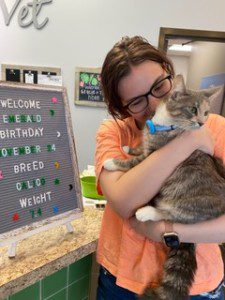Many college students grow up with pets in their homes. When they go off to college, in addition to all the adjustments to college life, they also have to adjust to life without their constant companion. My second half of my first year and the first semester of my sophomore year I was at home, not on campus, due to the COVID-19 pandemic. It was a bittersweet experience. On one hand, I wanted to be on campus with my friends and have a “normal” college experience. On the other hand, being home was comforting and familiar during a frightening and uncertain time. One of the most comforting aspects of being at home was being with my cats. Being able to be in class with a cat on my lap, on my desk, or next to me, made everything so much easier. Petting them and feeling their weight on my lap and unconditional affection helped to calm me down during tests and other stressful situations. Being responsible for their needs helped keep me on a schedule.
Through this experience, I gradually realized that I was benefiting from having an animal around me. More specifically, I was experiencing the therapeutic effects of an emotional support animal (ESA). Naomi Weinshenker, MD defines ESAs as “Animals that provide comfort and help relieve symptoms of a person’s disability.” Some benefits of having a pet include increased activity, reduced stress and anxiety, increased mindfulness, and decreased loneliness. Studies have also shown that having a pet decreases blood pressure, cholesterol levels, and triglyceride levels.
According to the Mayo Clinic health system, “One in three college students experiences significant depression and anxiety,” meaning that 33% of students are experiencing those symptoms at any given time. College students are facing a
mental health crisis that has gotten worse due to the COVID-19 pandemic. I have seen many of my peers, close friends, and even myself struggle with mental health. One solution that could help improve mental health is to promote ESAs on college campuses.
Many colleges, like mine, acknowledge the value of an ESA for students. Another benefit of having an ESA is the release of the hormone oxytocin or the “bonding hormone.” A study in 2021 found that participants that had a longer interaction with their ESA had higher amounts of oxytocin than the control group of participants. There is data to suggest that ESAs are especially helpful for those going through a mental health crisis. A study done in 2014 found that animals provide “nonjudgmental social support” and “unconditional love,” social connection, structure, positive behaviors, activity, and interest.
In addition to offering accommodations for ESAs, many colleges and universities offer other ways for students to have contact with animals to provide comfort and relieve stress. Some bring animals to campus during finals or even offer goat yoga! Others offer opportunities for students to foster service dogs that will ultimately be trained to aid individuals with disabilities, which provides animal comfort both to the person fostering and to others on campus who get to interact with the animals on campus.
Despite these benefits to college students, having an ESA of your own on campus can be challenging, particularly regarding space and time. College dorms are small, especially if you are sharing a room. While for some ESAs that is fine, such as cats, lizards, or guinea pigs, for some dogs, this would pose a problem. Other issues that someone can face is time and money. Some individuals may not be able to afford adopting the animal, housing it, and giving it the necessities. Additionally, some animals need more attention (i.e., dogs versus lizards). Finally, a big issue is being mindful of those with allergies. For example, two of my friends are allergic to cats. So whenever I get to hang out with them I have to be mindful that I don’t have cat fur all over my clothes.
In the spring 2021, students were allowed back to campus, and I missed my cats greatly. I would go to the local cat cafe every weekend and it brought me a lot of comfort. Soon, I began volunteering there every Tuesday and Sunday. At this time, I began to investigate having a cat of my own. My process of getting an ESA approved was easier than most. For most people, they find a pet and then apply to be approved for an ESA. I did the opposite. Since I knew that I wanted to have an ESA when I returned to campus for my junior year, I took care of all the paperwork in the spring of my sophomore year. The hardest part for me was contacting the correct person and making sure that my roommates would be comfortable with it. For other people, the hardest part was contacting and getting the paperwork from their mental health provider. However, since I have talked about my cats and potentially getting an ESA for a while, it was easy to get that paperwork accomplished.
Once I was approved, I began to look at cats on my local adoption center’s website. I didn’t have many expectations; all I knew was that I didn’t want a kitten. I think that kittens are cute, but for my purposes, I needed a more relaxed cat. I saw this little cat, almost a year old, who was meowing at me desperately through her cage. After spending some time with her, I decided that this was the cat I wanted and I would not leave without her. I named her Emerald. I have seen many benefits in having Emerald with me at college. First, she makes sure that I wake up in the morning at the same time. Now this can be negative to some people, especially on weekends. It is a blessing for me since I have difficulty getting out of bed when I am anxious or depressed. I know that I have to get up and feed her or she will keep meowing and nipping at my arms. Second, she keeps me in routine throughout the day based on her schedule.

Caroline, student at Ithaca College, with Emerald
I feed her wet food at 5:00pm and start making my own dinner, which prompts me to eat at regular times. I then play with her to get her energy and zoomies out. While doing homework, she either watches the world outside or tries to sit on my computer. Third, after a long day of classes and work, it is comforting to come to my apartment and have her immediately come up to me with her affectionate nudges. It takes my mind off of the stresses of the day and relaxes me to prepare for the next day. She cuddles up next to or on top of me and lays on my chest like a weighted blanket, resulting in deep pressure stimulation that reduces anxiety and depression and improves sleep quality.
The responsibility of caring for a pet inevitably has its challenges for busy college students who not only have a full course load but also extracurricular activities, athletics, and jobs. Caring for an animal takes time, and you have to ensure the pet is cared for if you are gone for a long period of time. You also need to figure out transporting the animal to and from campus. I live eight hours away from my college, so I have to drive back and forth during breaks and long car rides can be stressful for animals. For me, however, the benefits of having an ESA far outweigh the burdens, and having Emerald at school has improved my motivation, performance, and mental health.
Sources
https://www.cdc.gov/healthypets/keeping-pets-and-people-healthy/how.html
https://newsinhealth.nih.gov/2018/02/power-pets
https://www.insider.com/guides/health/mental-health/emotional-support-animal




